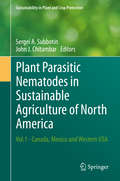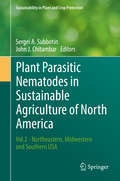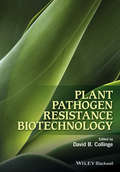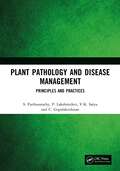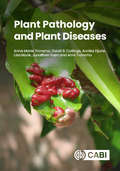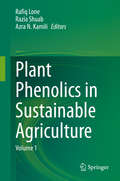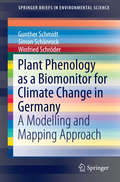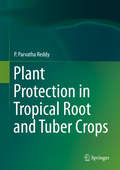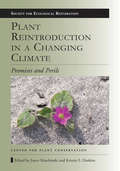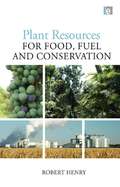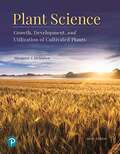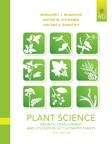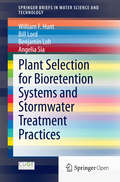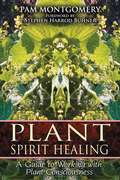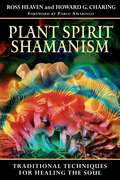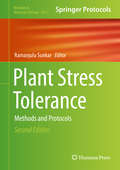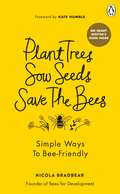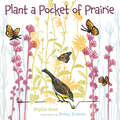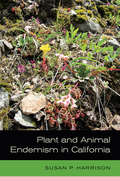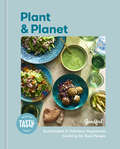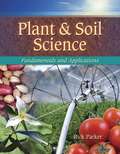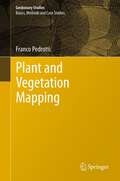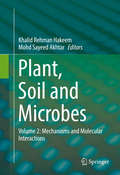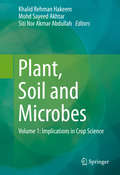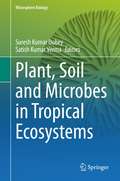- Table View
- List View
Plant Parasitic Nematodes in Sustainable Agriculture of North America: Vol. 1 - Canada, Mexico And Western Usa (Sustainability In Plant And Crop Protection Ser.)
by Sergei A. Subbotin John J. ChitambarPlant-parasitic nematodes are recognized as one of the greatest threats to crop production throughout the world. Estimated annual crop losses of $8 billion in the United States and $78 billion worldwide are attributed to plant parasitic nematodes. Plant parasitic nematodes not only cause damage individually but form disease-complexes with other microorganisms thereby increasing crop loss. Nematode diseases of crops are difficult to control because of their insidious nature and lack of specific diagnostic symptoms which closely resemble those caused by other plant pathogens and abiotic diseases. Future developments of sustainable management systems for preventing major economical agricultural losses due to nematodes is focused on strategies that limit production costs, enhance crop yields, and protect the environment. This book presents a first compendium and overview for nematode problems and their management across North America. Each chapter provides essential information on the occurrence and distribution of plant parasitic nematodes, their major crop hosts, impact on crop production and sustainable management strategies for each region of the continent including, Canada, Mexico and all states of the USA. For each region, a thematic overview of changes in crop production affected by plant parasitic nematodes and their management strategies over time will provide invaluable information on the important role of plant parasitic nematodes in sustainable agriculture.
Plant Parasitic Nematodes in Sustainable Agriculture of North America: Vol. 1 - Canada, Mexico And Western Usa (Sustainability In Plant And Crop Protection Ser.)
by Sergei A. Subbotin John J. ChitambarPlant-parasitic nematodes are recognized as one of the greatest threats to crop production throughout the world. Estimated annual crop losses of $8 billion in the United States and $78 billion worldwide are attributed to plant parasitic nematodes. Plant parasitic nematodes not only cause damage individually but form disease-complexes with other microorganisms thereby increasing crop loss. Nematode diseases of crops are difficult to control because of their insidious nature and lack of specific diagnostic symptoms which closely resemble those caused by other plant pathogens and abiotic diseases. Future developments of sustainable management systems for preventing major economical agricultural losses due to nematodes is focused on strategies that limit production costs, enhance crop yields, and protect the environment. This book presents a first compendium and overview for nematode problems and their management across North America. Each chapter provides essential information on the occurrence and distribution of plant parasitic nematodes, their major crop hosts, impact on crop production and sustainable management strategies for each region of the continent including, Canada, Mexico and all states of the USA. For each region, a thematic overview of changes in crop production affected by plant parasitic nematodes and their management strategies over time will provide invaluable information on the important role of plant parasitic nematodes in sustainable agriculture.
Plant Pathogen Resistance Biotechnology
by David CollingePlant pathogens and diseases are among the most significant challenges to survival that plants face. Disease outbreaks caused by microbial or viral pathogens can decimate crop yields and have severe effects on global food supply. Understanding the molecular mechanisms underlying plant immune response and applying this understanding to develop biotechnological tools to enhance plant defense against pathogens has great potential for moderating the impact of plant disease outbreaks. Plant Pathogen Resistance Biotechnology's main focus is an in depth survey of the biological strategies being used to create transgenic disease resistant plants for sustainable plant resistance Plant Pathogen Resistance Biotechnology is divided into four sections. The first section covers biological mechanisms underpinning disease resistance in plants, while the second highlights case studies of important pathogen-crop groups and then considers why the application of important pathogen-crop groups, transgenic-based strategies designed to selectively target pathogens could benefit crop production. The third section provides information on the status of transgenic crops around the world, and finally the last part explores high-tech alternatives to genetic engineering for developing disease resistant traits in plants. Edited and authored by leaders in the field, Plant Pathogen Resistance Biotechnology will be an invaluable resource to those studying or researching plant biotechnology, plant pathology, plant biology, plant and crop genetics, in addition to crop science.
Plant Pathology and Disease Management: Principles and Practices
by S. Parthasarathy C. Gopalakrishnan P. Lakshmidevi V.K. SatyaThis book introduces the nature, causes and impact of plant diseases. It briefly describes the history of plant pathology as a scientific discipline and introduces the disease cycle as the key tool for understanding disease development and devising appropriate management strategies. It addresses the mechanisms of pathogenicity and immunity. It explores the biology of the interactions between plants and plant pathogens from the cellular level to the population level, with the chapter addressing epidemiology. The book then concerns the approaches we can take to alleviate the effects of plant pathogens. Print edition not for sale in India.
Plant Pathology and Plant Diseases
by Anne Marte Tronsmo David B Collinge Annika Djurle Lisa Munk Jonathan Yuen Arne TronsmoThis textbook provides a comprehensive introduction to all aspects of plant diseases, including pathogens, plant-pathogen interactions, their management, and future perspectives. Plant diseases limit potential crop production and are responsible for considerable losses in agriculture, horticulture and forestry. Our global food production systems are under increasing pressure from global trade, climate change and urbanization. If we could alleviate the losses due to plant diseases, we would be able to produce roughly 20% more food - enough to feed the predicted world population in 2050. Co-authored by a group of international teachers of plant pathology who have collaborated for many years, the book gives expert and seamless coverage. Plant Pathology and Plant Diseases: Addresses major advances in plant-pathogen interactions, classification of plant pathogens, and the methods of managing or controlling disease Is relevant for a global audience; it covers many examples of diseases with an impact worldwide but with an emphasis on disease of particular importance in a temperate context Features over 400 striking figures and colour photographs It is suitable for graduate students and advanced undergraduates studying plant pathology, biology, agriculture and horticulture.
Plant Phenolics in Sustainable Agriculture: Volume 1
by Rafiq Lone Razia Shuab Azra N. KamiliThis book presents the latest research on plant phenolics, offering readers a detailed, yet comprehensive account of their role in sustainable agriculture. It covers a diverse range of topics, including extraction processes; the role of plant phenolics in growth and development; plant physiology; post-harvesting technologies; food preservation; environmental, biotic and abiotic stress; as well as nutrition and health. Further the book provides readers with an up-to-date review of this dynamic field and sets the direction for future research. Based on the authors’ extensive experience and written in an engaging style, this highly readable book will appeal to scholars from various disciplines. Bringing together work from leading international researchers, it is also a valuable reference resource for academics, researchers, students and teachers wanting to gain insights into the role of plant phenolics in sustainable agriculture.
Plant Phenology as a Biomonitor for Climate Change in Germany
by Winfried Schröder Gunther Schmidt Simon SchönrockThe investigations refer to the development of plant phenology since the 1960s in Germany. Spatiotemporal trends were assessed by means of regression kriging. It could be shown that there already is a distinct shift of phenological onset towards the beginning of the year of up to two weeks. In future, a shift of up to one month was calculated till 2080. Moreover, a prolongation of the vegetation period of up to three weeks was found. The findings are relevant for the development of mitigation measures to prevent from environmental, agricultural and economic issues due to climate change.
Plant Protection in Tropical Root and Tuber Crops
by P. Parvatha ReddyThis book is a compilation of information on insect/mite/vertebrate pests and fungal/bacterial/viral/mycoplasma/nematode diseases of tropical root and tuber crops such as cassava, sweet potato, yams, taro, Amorphophallus, yam bean and tannia. The book highlights the distribution, symptoms and damage, biology, survival and spread of each pest and describes management methods. It also sheds light on different eco-friendly pest management strategies including physical, cultural, chemical, biological, host resistance and integrated methods. The book is written in a lucid style using easy-to-understand language and offers adoptable recommendations involving eco-friendly control measures. It serves as a useful reference source for policy makers, research and extension workers, practicing farmers and students. The material can also be used for teaching post graduate courses in state agricultural universities.
Plant Reintroduction in a Changing Climate: Promises and Perils (Science Practice Ecological Restoration)
by Kristin E. Haskins Joyce MaschinskiThis volume presents a comprehensive review of reintroduction projects and practices, the circumstances of their successes or failures, lessons learned, and the potential role for reintroductions in preserving species threatened by climate change. Contributors examine current plant reintroduction practices, from selecting appropriate source material and recipient sites to assessing population demography. The findings culminate in a set of Best Reintroduction Practice Guidelines, included in an appendix to the book. These guidelines cover stages from planning and implementation to long-term monitoring, and offer not only recommended actions but also checklists of questions to consider that are applicable to projects around the world. Plant Reintroduction in a Changing Climate is a comprehensive and accessible reference for practitioners to use in planning and executing rare plant reintroductions.
Plant Resources for Food, Fuel and Conservation
by Robert James HenryAgriculture and food production have a large footprint on the landscape globally and compete for space with land for nature conservation. This book explores the competition between the food needs of a growing human population and the conservation of biodiversity as intensified by the emerging use of crops for energy production. As concern about the impact of greenhouse gas emissions on climate grows and oil prices increase, energy production from agricultural crops has become a significant industry. At the same time, growth in food demand due to population growth has been accelerated by growing affluence associated with economic growth in major developing countries increasing per capita consumption. Consumers are concerned that the price of food will continue to increase sharply as a result of this competition but a loss of biodiversity may be another major outcome. Drawing on his expertise in plant conservation genetics, the author provides a balanced appraisal of the potential for developing new or improved crops for food or bioenergy production in the context of climate change, while at the same time protecting biodiversity.
Plant Science: Growth, Development, And Utilization Of Cultivated Plants
by Margaret McMahonThorough foundation in plant cultivation suitable for learners of all levels Plant Science: Growth, Development, and Utilization of Cultivated Plants is the premier resource on the basic principles of ecological relationships and their impact on cultivation. Comprehensive and engaging, Plant Science addresses all relevant topics, from the fundamentals of botany to complex cultivation strategies and sustainability concerns. The breadth of topics covered by this text make it ideal for most plant science courses, including the combined agronomy-horticulture curricula that universities are increasingly adopting. The 6th edition has been updated with a wealth of new information, images, and features, and now draws a stronger connection between natural, agricultural, and horticultural ecosystems.
Plant Science: Growth, Development, and Utilization of Cultivated Plants
by Margaret E. Mcmahon Anton M. Kofranek Vincent E. RubatzkyPlant Science: Growth, Development, and Utilization of Cultivated Plants, Fifth Edition, is an outstanding resource for anyone with an interest in how plants are grown and utilized for maintaining and adding enjoyment to human life. The text starts with the fundamentals of botany, plant physiology, and environmental factors affecting plant growth, while later sections integrate those topics into strategies of producing plants for human use as food, fiber, and recreation. The concept of sustainability and sustainable methods of growing plants runs throughout the text. Whether you are familiar or unfamiliar with plant science, this book will give you a firm understanding of concepts and terminology related to the growing of plants.
Plant Selection for Bioretention Systems and Stormwater Treatment Practices
by William F. Hunt Bill Lord Benjamin Loh Angelia SiaAs cities develop, more land is converted into impervious surfaces, which do not allow water to infiltrate. Careful urban planning is needed to ensure that the hydrologic cycle and water quality of the catchment areas are not affected. There are techniques that can attenuate peak flow during rain events and reduce the amount of metals, nutrients, and bacteria that enter the urban water cycle. This brief gives a short introduction on bioretention systems and documents the effectiveness of some 36 plant species in removing water pollutants. A summary on the maintenance requirements is also presented.
Plant Spirit Healing: A Guide to Working with Plant Consciousness
by Stephen Harrod Buhner Pam MontgomeryA hands-on approach to working with the healing powers of plant spirits • Explores the scientific basis underlying the practices of indigenous healers and shamans • Illuminates the matrix where plant intelligence and human intelligence join • Reveals that partnering with plants is an evolutionary imperative Indigenous healers and shamans have known since antiquity that plants possess a spirit essence that can communicate through light, sound, and vibration. Now scientific studies are verifying this understanding. Plant Spirit Healing reveals the power of plant spirits to join with human intelligence to bring about profound healing. These spirits take us beyond mere symptomatic treatment to aligning us with the vast web of nature. Plants are more than their chemical constituents. They are intelligent beings that have the capacity to raise consciousness to a level where true healing can take place.In this book, herbalist Pam Montgomery offers an understanding of the origins of disease and the therapeutic use of plant spirits to bring balance and healing. She offers a process engaging heart, soul, and spirit that she calls the triple spiral path. In our modern existence, we are increasingly challenged with broken hearts, souls in exile, and malnourished spirits. By working through the heart, we connect with the soul and gain access to spirit. She explains that the evolution of plants has always preceded their animal counterparts and that plant spirits offer a guide to our spiritual evolution--a stage of growth imperative not only for the healing of humans but also the healing of the earth.
Plant Spirit Shamanism: Traditional Techniques for Healing the Soul
by Pablo Amaringo Ross Heaven Howard G. CharingAn in-depth look at the role of plant spirits in shamanic rituals from around the world • Shows how shamans heal using their knowledge of plant spirits as well as the plant’s “medical properties” • Explores the core methods of plant shamanism--soul retrieval, spirit extraction, and sin eating--and includes techniques for connecting with plant spirits • Includes extensive field interviews with master shamans of all traditions In Plant Spirit Shamanism, Ross Heaven and Howard G. Charing explore the use of one of the major allies of shamans for healing, seeing, dreaming, and empowerment--plant spirits. After observing great similarities in the use of plants among shamans throughout the world, they discovered the reason behind these similarities: Rather than dealing with the “medical properties” of the plants or specific healing techniques, shamans commune with the spirits of the plants themselves. From their years of in-depth shamanic work in the Amazon, Haiti, and Europe, including extensive field interviews with master shamans, Heaven and Charing present the core methods of plant shamanism used in healing rituals the world over: soul retrieval, spirit extraction, sin eating, and the Amazonian tradition of pusanga (love medicine). They explain the techniques shamans use to establish connections to plant spirits and provide practical exercises as well as a directory of traditional Amazonian and Caribbean healing plants and their common North American equivalents so readers can ex-plore the world of plant spirits and make allies of their own.
Plant Stress Tolerance
by Ramanjulu SunkarA number of abiotic factors such as drought, salinity, extreme temperatures, low or high light intensity, and deficiency or toxic levels of nutrients have huge impacts on crop productivity, and a furthering of our understanding of the molecular, biochemical, and physiological basis of stress tolerance has been widely recognized as critical. In Plant Stress Tolerance: Methods and Protocols, expert researchers cover the most important widely-used techniques, including cutting-edge strategies, in a manner that ensures effective results. Beginning with reviews on dehydration, salinity, and cold tolerance as well as on oxidative stress, the volume then continues with methods involving topics such as describing the identification of stress-regulated genes, proteins, and microRNAs using diverse approaches, measurement of osmotic adjustment, proline levels, enzymes involved in proline metabolism, and sugars as well as determination of ROS levels, lipid peroxidation, ion leakage, and the enzymes involved in ROS detoxification. Written in the highly successful Methods in Molecular Biology(tm) series format, chapters include introductions to their respective subjects, lists of the necessary materials and reagents, step-by-step, readily reproducible laboratory protocols, and tips on troubleshooting and avoiding known pitfalls. Comprehensive and up-to-date, Plant Stress Tolerance: Methods and Protocols provides a wide range of easy-to-follow protocols catering to the needs of plant physiologists, biochemists, and molecular biologists interested in probing this vital area of study.
Plant Trees, Sow Seeds, Save The Bees: Simple ways to bee-friendly
by Nicola BradbearDiscover the wonder of bees (and other stripey insects) and how to help them survive. In this little book of bees, wasps, hoverflies and more, discover the easy ways to make your gardens, window boxes and pots insect havens. Rewild your garden with plants for bees and honeybees - simple acts of kindness to save the planet. Expert Nicola Bradbear, from Bees for Development charity, shows you how and why it's so important.There are lots of fun things you can do to make a big difference.With every book sold, proceeds will be donated to Bees for Development (www.beesfordevelopment.org)
Plant a Pocket of Prairie
by Phyllis RootAuthor Phyllis Root and illustrator Betsy Bowen last explored the vast, boggy peatlands of northern Minnesota in their book Big Belching Bog. Now, in Plant a Pocket of Prairie, Root and Bowen take young readers on a trip to another of Minnesota&’s important ecosystems: the prairie. Once covering almost 40 percent of the United States, native prairie is today one of the most endangered ecosystems in the world. Plant a Pocket of Prairie teaches children how changes in one part of the system affect every other part: when prairie plants are destroyed, the animals who eat those plants and live on or around them are harmed as well. Root shows what happens when we work to restore the prairies, encouraging readers to &“plant a pocket of prairie&” in their own backyards. By growing native prairie plants, children can help re-create food and habitat for the many birds, butterflies, and other animals that depend on them. &“Plant cup plants,&” Root suggests. &“A thirsty chickadee might come to drink from a tiny leaf pool. Plant goldenrod. A Great Plains toad might flick its tongue at goldenrod soldier beetles.&” An easy explanation of the history of the prairie, its endangered status, and how to go about growing prairie plants follows, as well as brief descriptions of all the plants and animals mentioned in the story. With Betsy Bowen&’s beautiful, airy illustrations capturing the feel of an open prairie and all its inhabitants, readers of all ages will be inspired to start planting seeds and watching for the many fascinating animals their plants attract. What a marvelous transformation could take place if we all planted a pocket of prairie!
Plant and Animal Endemism in California
by Susan P. HarrisonCalifornia is globally renowned for its biological diversity, including its wealth of unique, or endemic, species. Many reasons have been cited to explain this abundance: the complex geology and topography of its landscape, the special powers of its Mediterranean-type climate, and the historic and modern barriers to the wider dispersal of its flora and fauna. Plant and Animal Endemism in California compiles and synthesizes a wealth of data on this singular subject, providing new and updated lists of native species, comparing patterns and causes of both plant and animal endemism, and interrogating the classic explanations proposed for the state's special significance in light of new molecular evidence. Susan Harrison also offers a summary of the innovative tools that have been developed and used in California to conserve and protect this stunning and imperiled diversity.
Plant and Planet: Sustainable and Delicious Vegetarian Cooking for Real People
by GoodfulSimple steps can make an impact on our planet. From BuzzFeed&’s Goodful, these 75 plant-based recipes plus plenty of low-waste strategies will guide you to a sustainable life you can feel good about.Goodful offers approachable recipes, tips, and guides for everyday life. In Plant and Planet, discover seventy-five plant-based recipes for meal prep, everyday celebrations, and cooking with the seasons, from Zucchini Lasagna Boats and Black Bean & Walnut Quesadillas to Caramelized Banana & Orange Parfaits, along with tons of ways to stock your kitchen, grow your own ingredients, turn your scraps into amazing treats, and more. Beautifully photographed, this cookbook is super practical and impactful, with surprising and easy ways to reduce environmental impact, shopping guides and meal plans, information about repurposing food waste, plus a guide to growing your own ingredients. You will learn how to:• Approach cooking from a seasonal perspective• Minimize packaging while maximizing flavor• Clear out your fridge and freezer to make comforting soups, salads, and other dishesFeaturing contributions from experts DeVonn Francis, Lorena Ramirez, Lauren Singer, Nadiya Hussain, Kelis Rogers, David Zilber, and Ben Flanner, Plant and Planet is filled with tips and quick hits of information about the environmental impact of these recipes--all to deliver a low-stress, high-impact path to a low-waste kitchen.
Plant and Soil Science: Fundamentals and Applications
by Rick ParkerThis book combines the basic knowledge of plant and soil science, in an easy to read and teach format, and provides practical real world application for information learned. Organized into twenty-eight chapters, each chapter features learning objectives, key terms, tables, charts, illustrations and color photographs to aid the learning and teaching process.
Plant and Vegetation Mapping
by Franco PedrottiThe book is concerned principally with geobotanical mapping. Geobotany is a broad science that deals with the study of species and of vegetation communities in relation to the environment; it includes other, perhaps more familiar sciences, such as plant geography, plant ecology, and chorology, and phytosociology (plant sociology). Geobotanical cartography is a field of thematic cartography that deals with the interpretation and representation, in the form of maps, of those spatial and temporal phenomena that pertain to flora, vegetation, vegetated landscapes, vegetation zones, and phytogeographical units. The production of a geobotanical map represents the last stage in a cognitive process that begins with observations in the field and continues with the collection of sample data, interpretation of the phenomena observed, and their appropriate cartographic representation; geobotanical cartography is closely tied to the concepts and scope of geobotany in general
Plant, Soil and Microbes
by Khalid Rehman Hakeem Mohd Sayeed AkhtarThe interactions between the plant, soil, and microbes are very complex in nature and may be antagonistic, mutualistic, or synergistic, depending upon the types of microorganisms and their association with the plant and soil. The multi-trophictactics are involved in these types of interactions to nourish the plants in various habitats and conditions. Understanding the mechanisms of these interactions is highly desired to utilize the knowledge in such an eco-friendly and sustainable way, which may not only resolve the upcoming food security issues but also make the environment green by reducing the chemical inputs. Plant, Soil and Microbes: Mechanisms and Molecular Interactions, along with the recently published Plant, Soil and Microbes: Implications in Crop Science, provide detailed accounts of the exquisite and delicate balance between the three critical components of agronomy. Specifically, these two titles focus on the basis of nutrient exchange between the microorganisms and the host plants, the mechanism of disease protection and the recent molecular details emerged from studying this multitropic interaction. Together they provide a solid foundation for the students, teachers, and researchers interested in soil microbiology, plant pathology, ecology and agronomy.
Plant, Soil and Microbes
by Khalid Rehman Hakeem Mohd Sayeed Akhtar Siti Nor Akmar AbdullahThe interactions between the plant, soil and microbes are complex in nature. Events may be antagonistic, mutualistic or synergistic, depending upon the types of microorganisms and their association with the plant and soil in question. Multi-trophic tactics can therefore be employed to nourish plants in various habitats and growth conditions. Understanding the mechanisms of these interactions is thus highly desired in order to utilize the knowledge in an ecofriendly and sustainable way. This holistic approach to crop improvement may not only resolve the upcoming food security issues, but also make the environment greener by reducing the chemical inputs. Plant, soil and microbe, Volume 1: Implications in Crop Science, along with the forthcoming Volume 2: Mechanisms and Molecular Interactions, provide detailed accounts of the exquisite and delicate balance between the three critical components of agronomy. Specifically, these two titles focus on the basis of nutrient exchange between the microorganisms and the host plants, the mechanism of disease protection and the recent molecular details emerged from studying this multi-tropic interaction. Together they aim to provide a solid foundation for the students, teachers, and researchers interested in soil microbiology, plant pathology, ecology and agronomy.
Plant, Soil and Microbes in Tropical Ecosystems (Rhizosphere Biology)
by Satish Kumar Verma Suresh Kumar DubeyThis book describes the multitude of interactions between plant, soil, and micro-organisms. It emphasizes on how growth and development in plants, starting from seed germination, is heavily influenced by the soil type. It describes the interactions established by plants with soil and inhabitant microbial community. The chapters describe how plants selectively promote certain microorganisms in the rhizospheric ecozone to derive multifarious benefits such as nutrient acquisition and protection from diseases. The diversity of these rhizospheric microbes and their interactions with plants largely depend on plant genotype, soils attributes, and several abiotic and biotic factors. Most of the studies concerned with plant–microbe interaction are focused on temperate regions, even though the tropical ecosystems are more diverse and need more attention. Therefore, it is crucial to understand how soil type and climatic conditions influence the plant–soil–microbes interaction in the tropics. Considering the significance of the subject, the present volume is designed to cover the most relevant aspects of rhizospheric microbial interactions in tropical ecosystems. Chapters include aspects related to the diversity of rhizospheric microbes, as well as modern tools and techniques to assess the rhizospheric microbiomes and their functional roles. The book also covers applications of rhizospheric microbes and evaluation of prospects improving agricultural practice and productivity through the use of microbiome technologies. This book will be extremely interesting to microbiologists, plant biologists, and ecologists.
